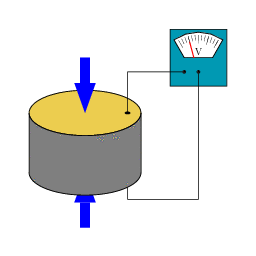WHAT IT IS
Electromagnetic induction
Electrical energy can be generated (or more precisely, energy can be converted to electricity) using seven fundamental methods. Two of the seven methods, namely electromagnetic induction and photovoltaic effect, are used more commonly in the modern energy industry, and hence will be the primary basis of most topics discussed in this site.
Electromagnetic induction is used almost exclusively in modern day commercial electricity production, with solar power (not solar thermal power, which uses electromagnet induction) being the only other major source using the photovoltaic effect method.
Electromagnetic induction is where an electrical generator, dynamo, or alternator, transforms kinetic energy into electricity. It is based on the Faraday’s Law, stating that rotating or moving an electromagnet or a permanent magnet within closed loops of conducting material such as copper will induce current.
Electromagnetic induction is used in nearly all types of commercial power stations, including hydroelectric power stations, wind farms, solar thermal (not solar photovoltaic) power stations, and many other smaller types. All confirmed types of power stations, and how the work, are further explained in detail later in the site.

The above 1892 drawing of Michael Faraday’s 1831 experiment illustrates that moving a permanent magnet (or an eletromagnet, as shown in the image), between coils of wire will create a magnetic field, and will induce current in the larger coil. Source: Wikimedia Commons/Public Domain
This image shows a turbine section being installed to a large electrical generator. The surrounding permanent magnets will induce electrical current within the central axle (not clearly visible) once the axel starts moving anticlockwise. This moving force will be gained by allowing water to flow through and turn the turbine (which is further explained later in the site). This generator is one of the many installed in the 7,000-megawatt (7 million watts) Grand Coulee Hydroelectric Dam. Source: Wikimedia Commons/Public Domain

Photovoltaic effect
Electromagnetic induction and photovoltaic effect constitutes to nearly 100% of the global commercial electricity generation. But unlike electromagnetic induction which utilized kinetic energy, photovoltaic effect directly converts radiant energy (light) into electrical energy, without the help of any moving parts.
Photovoltaic effect generates electrical power by converting solar radiation into direct current electricity using semiconductors that exhibit the photovoltaic effect. Photovoltaic power generation employs solar panels composed of a number of individual solar cells containing photovoltaic material. These materials include monocrystalline silicon, polycrystalline silicon, amorphous silicon, cadmium telluride, and copper indium gallium selenide/sulphide.
Solar cells convert energy from the sun into a flow of electrons. The photovoltaic effect refers to photons of light exciting electrons into a higher state of energy, allowing them to act as charge carriers for an electric current.

A commercial solar farm (right) is generally made up of hundreds to thousands of solar panels (each rectangular panels shown on right). Each panel consists of approximately 50 solar cells (left).
Source (right): Wikimedia Commons/CC-BY-SA-2.5
Source (left): Wikimedia Commons/CC-BY-3.0
Electrochemical effect
Electrochemical effect is the direct transformation of chemical energy, as in a battery, fuel cell, or nerve impulse.

An electrochemical cell setup resembling the Daniell cell. The two half-cells are linked by a salt bridge carrying ions between them. Electrons flow in the external circuit. Source: Wikimedia Commons/CC-BY-3.0
A thermoelectric conversion diagram (left), and a thermoelectric device capable of converting temperature differences directly into small amounts of electricity (right).
Source (left): Wikimedia Commons/CC-BY-SA-3.0
Source (right): Wikimedia Commons/Public Domain

Thermoelectric effect
Thermoelectric effect is the direct conversion of temperature differences to electricity, as in thermocouples, thermophiles, and thermionic converters.
Piezoelectric effect
Piezoelectric effect refers to the direct conversion of stress, strain, or pressure, to electricity. This process can be found in certain solid materials such as crystals, certain ceramics, and biological matter such as bone, DNA and proteins. Piezoelectricity is found useful in applications such as the production and detection of sound, generation of high voltages, electronic frequency generation, microbalances, and ultrafine focusing of optical assemblies. It is also the basis of a number of scientific instrumental techniques with atomic resolution, and everyday uses such as acting as the ignition source for cigarette lighters and push-start propane barbecues.

As shown on the left, a piezoelectric disk generates a voltage when deformed (change in shape is greatly exaggerated). Source: Wikimedia Commons/CC-BY-SA-3.0
Nuclear transformation
Nuclear transformation of nuclear potential energy directly to electricity by beta decay is used on a very small scale. In the common full-size nuclear power plants today, the heat of a nuclear reaction is used to run a heat engine, which drives a generator that converts mechanical energy into electricity by magnetic induction. Nuclear transformation is the creation and acceleration of charged particles such as betavoltaics or alpha particle emission.
Betavoltaics are generators of electrical current, in effect a form of battery, which use energy from a radioactive source emitting beta particles (electrons), with the most common source being tritium, a hydrogen isotope. This source is particularly well-suited to low-power electrical applications where long life of the energy source is needed, such as implantable medical devices, military use, or space applications.
Static electricity
Static electricity refers to the build-up of electric charge on the surface of objects. The static charges remain on an object until they either bleed off to ground or are quickly neutralized by a discharge. Static electricity can be with current (or dynamic) electricity, which can be delivered through wires as a power source.
The last five methods mentioned above are almost entirely excluded from large scale commercial electricity production due to being too inefficient, uneconomical, being under early stages of development, or impossible to be successfully deployed on a commercial scale due to various other reasons. Hence, these methods are largely excluded from considerations further in this website.
References
http://www.ndt-ed.org/EducationResources/HighSchool/Electricity/electroinduction.htm
http://books.google.lk/books?id=JzBAAAAAYAAJ
http://www.allaboutcircuits.com/vol_1/chpt_14/5.html
http://photovoltaics.sandia.gov/docs/PVFEffIntroduction.htm
http://www.scienzagiovane.unibo.it/english/solar-energy/3-photovoltaic-effect.html
http://encyclobeamia.solarbotics.net/articles/photovoltaic.html
http://buildgenerator.org/electricity-generation.html
http://imadegreen.com/electricity-generation-7-basic-types/
